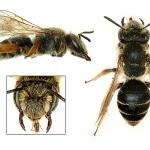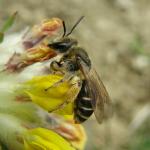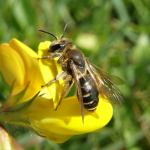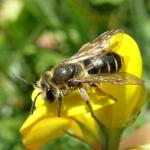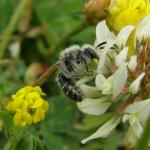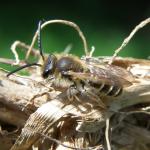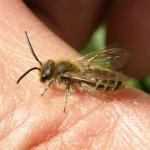Melitta wilkella Kirby, 1802, Andrena xanthura Kirby, 1802, Andrena convexiuscula Kirby, 1802, Melitta barbatula Kirby, 1802, Andrena convexa_homonym Schenck, 1853, Andrena quadristrigata Schenck, 1853, Andrena winkleyi Viereck, 1907, Andrena beaumonti Benoist, 1961
A close relative of A. ovatula (Kirby) and best separated from it by the broken hair-band in both sexes on the third gastral tergite (particularly obvious in the female).
Widely distributed throughout Britain, from East Kent to West Cornwall, northwards to East Sutherland and on the Isle of Man. In Ireland, it occurs from South Kerry and Wexford north to West Donegal (Stelfox, 1927; Ronayne & O’Connor, 2003). The Channel Island distribution is centred on the larger islands of Alderney (Luff, 1900), Guernsey (Richards, 1979), Herm (Luff, 1905), Jersey (Richards, 1979) and Sark (Luff, 1907).
The species has an Holarctic distribution, occurring widely in both Eurasia and North America. According to Gusenleitner & Schwarz (2002), the species is found from southern Fennoscandia south to Iberia, and east to Turkey and the former USSR; in North Africa it has been reported from Morocco. It has also been found in China (Yasumatsu, 1941). In the Nearctic, it occurs from Nova Scotia to Wisconsin, south to Virginia and Ohio (Hurd in Krombein et al., 1979) (Hurd (1979) presumes it is an introduction in North America).
This species is not regarded as being scarce or threatened.
Flower-rich grasslands, broad-leaved woodland clearings and private gardens.
Generally considered to be a univoltine species, flying in the spring from April to June. However, records in July and August (sometimes including individuals in freshly emerged condition) may indicate a partial second brood. A similar situation involving late summer activity has been noted in the former Czechoslovakia (Kocourek, 1966).
Females nest either singly (Chambers, 1949) or in huge, compact aggregations (Perkins, 1919). The species over-winters as a larva or prepupa (Meidell, 1967). Males are often seen flying in large numbers about the foliage of bushes and trees.
Sea campion, sheep’s sorrel, thrift, willow, mustard, cherry, hawthorn, sainfoin, common bird’s-foot-trefoil, tufted vetch, bush vetch, broad bean, melilot, white clover, red clover, broom, spurge, gorse, alder buckthorn, maple, water-dropwort, bogbean, speedwell, dandelion, ragwort, unidentified grasses.
Nomada striata Fabricius is a cleptoparasite of this species. Specimens of A. wilkella are often stylopised, apparently by Stylops thwaitei Saunders. This stylops may be the species that Perkins (1918) called Stylops wilkella. Formerly these affected bees were misidentified,being given the name Andrena convexiuscula Kirby (e.g. Smith, 1855). Such stylopised bees tend to fly earlier in the flight period than unaffected individuals. In Norway, Meidell (1967) observed male Stylops (species not cited) emerging from a female A. wilkella.
2012


